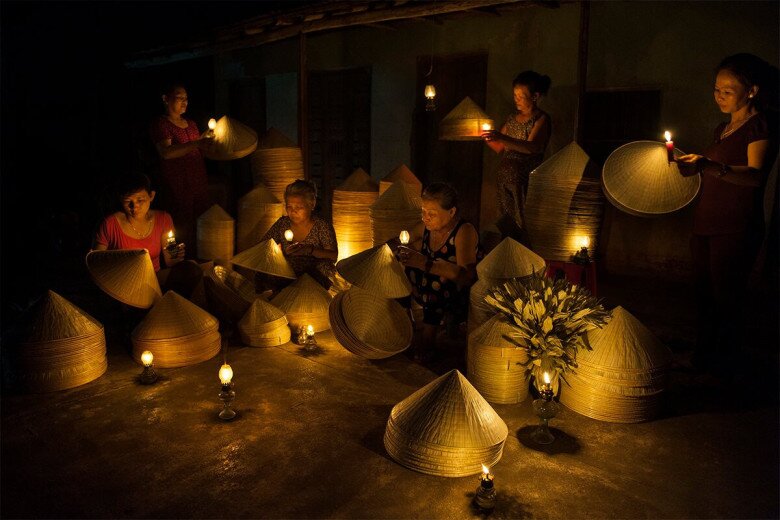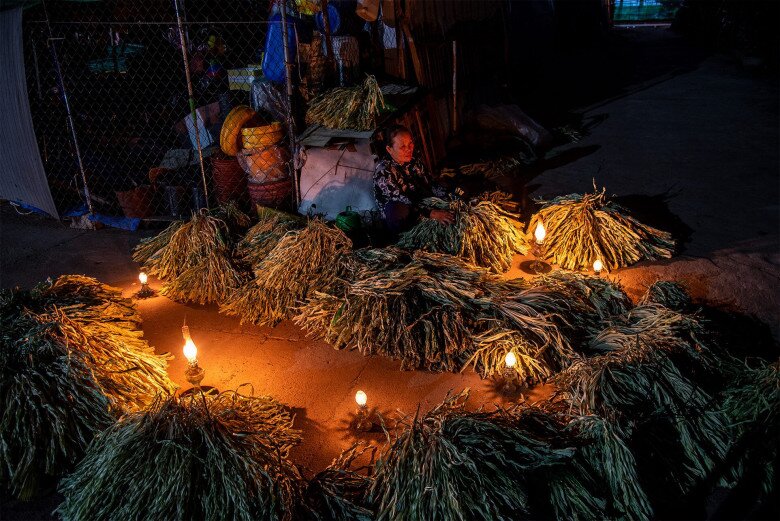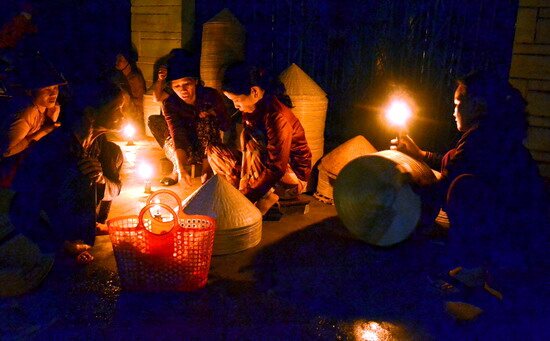Go Gang Town (Nhon Thanh Commune, An Nhon District, Binh Dinh Province) has left many memories for visitors thanks to its unique hat market, which takes place from 3 to 4 am until dawn. This is considered a “one-of-a-kind” market. For hundreds of years, despite bombs and storms, the market has been bustling under the dim light of oil lamps. Although no one remembers exactly when the first market took place, the unique cultural features remain.

The hat-making profession in Go Gang dates back to the time of the Tay Son – Nguyen Hue dynasty, and the process of making horse hats was very intricate and meticulous back then.
The hats are made from tre cật (a type of bamboo) rings, which are whittled down to the size of toothpicks and woven into three layers of ribs. The outside layer is made of young kè leaves, sewn together with white silk thread. The hat’s apex is usually adorned with a silver or tortoiseshell cap, intricately carved with dragon, lyre, tortoise, and phoenix motifs. The hat’s strap is made of red or green silk, with a tuft under the chin. It took a month for artisans to create a horse hat, hence the high price, which was only affordable for those of high social status, such as court officials.
Over time and with the demands of the people, the horse hat evolved into simpler versions, such as the single horse hat, the trader’s hat, and the chũm hat, which were more affordable. These hats did not have the intricate silver or tortoiseshell caps but instead featured colorful tassels at the tip to add a touch of beauty. In wedding processions in the hat-making region, the rich would carry the bride in a palanquin, with the groom wearing a hat and riding a horse. Even poor families tried to afford a set of horse hats for the bride and groom to wear on their special day.
Every day, around 6 am, the artisans begin the process of pedaling leaves in the sand, which takes about three hours. Once done, they bundle the leaves into small bundles and sun-dry them for another three hours. Next, the leaves are brought in for fermentation, then dried over charcoal and dew to soften and straighten them. The leaf material is mainly sourced from Cat Tan Commune (Phu Cat District, Binh Dinh Province) and some neighboring areas.
If you have the opportunity to visit Nhon Thanh Ward, take some time to explore the Go Gang hat market in the quiet of the night. There, you will experience the unique culture of a land filled with sunshine, wind, and human warmth. At the same time, the place also evokes memories of a heroic past led by the cloth-clad hero Quang Trung – Nguyen Hue.

The Go Gang hat market opens around 3 am and ends at dawn, hence its nickname, the “rooster’s crow” market.
According to the elders in Tien Hoi, this hat market dates back to the Tay Son era. During that time, the Phu Gia horse hats (from Cat Tuong Commune, Phu Cat District) were famous, but they were exclusively for the king and high-ranking officials. In contrast, the Go Gang leaf hats were created later to serve the soldiers of the Tay Son army. The early morning market hours also allowed people to buy and sell before heading to the fields or doing other work when the sun rose.
The Go Gang hat market exclusively sells leaf hats and hat-making supplies, nothing else. Trading activities take place under the light of street lamps or flashlights. Despite being a market, the atmosphere is not noisy or bustling; it is just enough to stir a quiet corner of the countryside.
Perhaps those who participate in the market are mindful of the sleep of the nearby residents, so they move and converse softly, just enough for buyers and sellers to hear each other. Here, no one competes for selling space; those who come later will set up next to those who came earlier, forming a long line along the road.

In the past, the Go Gang hat market was more bustling, as people brought their leaf hats and hat-making materials to sell.
However, nowadays, the market sees fewer people, as most of the hats are bought by traders directly from the artisans’ homes the evening before. Therefore, going to the market now mainly involves buying and selling hat-making materials. Occasionally, every few market days, a few elderly people bring their hats to sell, not because the traders don don’t come to buy them, but to keep the tradition of the Go Gang hat market alive. The elders believe that a hat market should have hat sellers to live up to its name. In the past, the market was truly fascinating, with trading activities taking place under the light of oil lamps, but now, with the advent of streetlights, no one uses oil lamps anymore.

When the streetlights go out, they rely on flashlights.
At this “rooster’s crow” market, after completing the purchase of hat-making materials, the women quietly return home, some by motorbike, some by bicycle, and others on foot, to begin their agricultural work.
Although the Go Gang hat market is not as bustling as it used to be, it will surely not disappear. The hat-makers here are always eager to preserve their traditional craft and the unique market left by their ancestors. Through tourism promotion programs over the years, the hat market has attracted many foreign tourists and tour groups interested in discovering the unique culture of this region. This has also raised awareness of cultural heritage preservation among the community and local authorities.






























